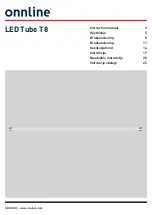
Safety information
9
• Ensure that the system is electrically connected to ground (earth) as
described in this guide.
• Either power outlet sockets or hard-wired circuits that incorporate power
on/off switches must be used to supply the system with power. Power
plugs and/or power on/off switches must be easily accessible so that
the system can be isolated from power quickly.
• Provide a means of locking out power (ensure that power can be shut
down and is impossible to reapply, even accidentally) during service.
• Connect the PSU to AC mains power and relay power from one PSU to
another using only 3-conductor neoprene- or hypalon-jacket cable that
is heat resistant to minimum 90° C (194° F), rated minimum 16 amps,
approved for the installation environment (UV, temperature, outdoor
use, etc.) and has an external diameter of 6
12 mm (0.24
0.47 inch).
In North America the power cable must be type SJO or type SOOW,
minimum 16/3 AWG and rated minimum 300 VAC. In the EU the cable
must be minimum 2.5 mm² conductor size and HAR approved or
equivalent.
• Use only hybrid (combined power and data) luminaire cables installed
in Luminaires by Martin™ or its authorized agents to connect
Luminaires. If the 3 m (9.8 ft.) luminaire cable supplied pre-installed is
too short, extend it only with the extension cable kit available from
Martin™.
• Use only the hybrid (combined power and data) Splitter cables supplied
by Martin for the products concerned to connect a PSU to Splitters and
to connect Splitters to each other.
• Do not connect the system to power unless all cable glands are sealed
by either a cable or a blanking plug installed as described in this guide.
• Before using the system, check that all power distribution equipment
and cables are in perfect condition, rated for the current requirements of
all connected devices, protected to IP68 or higher and of suitable type
for the location (including water, pollution, temperature and UV
resistance).
• Protect all external connections inside suitable waterproof junction
boxes or as required by local laws, regulations or codes. Ensure that
the ends of cables cannot come into contact with water or moisture, as
the vacuum created in devices during cooldowns can suck moisture up
cable.
• Isolate the system from power immediately if any device, cable, cable
gland or power plug is in any way damaged or defective, or if there are
any signs of overheating. Do not reapply power until the fault has been
rectified.
• Do not operate the system if any cover or component is missing,
damaged or deformed.
• Shut down power to the system when it is not in use.










































